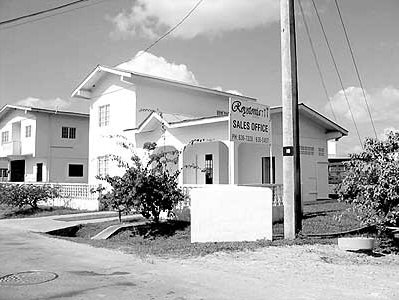| The real Roystonia story
Published
Thursday 20th May, 2004

The sales office of the Roystonia Development in Couva
North. Inset: A welcome sign to the development identifying the
parties involved in construction and finance.
Photo: Adrian Boodan
This week we take a necessary pause from
the Caroni series to look at some of the issues arising from the furore
over the Roystonia Development in Couva North.
The main events are summarised in the
sidebar as background to this article. We do not intend to pronounce on
the legal and political issues. Leave those to our political pundits and
learned friends.
It is our view that the scope of the
discussion thus far underlines our limitations when having public policy
disputes. Once again, we seem to be drawn to the question of the
legality of the contract and so on. It all seems a little distracting.
The issues of investment policy, risk and
returns are receiving scant attention. We will only make progress if
these are constructively and openly addressed. We will be making a start
here.
It is our view that the legal issues are
subsidiary to the fundamentals of any deal. Businessmen make deals and
these are sometimes passed to lawyers for recording in contracts or
deeds. As interesting as the legal issues are, they merely outline the
underlying ethos of any arrangement.
We need to outline a series of measures
with which we can assess agreements of this type and the key questions
would be:
Risk
The investment policy of a properly run
company would include guidelines as to the risk levels and the
respective proportions of various investments. The approaches can be
illustrated as being either low-risk with relatively modest returns or
greater-risk with the possibility of greater returns. The correct
management of risk and return is critical to successful investment.
Of course the State has a role in
providing support in those areas which would not receive the desired
levels from the free market. Some examples would include the school
feeding programme, public health programmes, PTSC’s rural bus system and
so on. Point being that it is acceptable for taxpayers’ money to be
invested if some critical need is being fulfilled. The public supports
these expenditures since they add to the common good.
The NHA seems to have made a significant
initial outlay and there now seems to be an issue of the profits from
the development being quite limited. The NHA seems to have made a risky
investment here. What private landowner would enter such a scheme? What
was the return to the public?
How much of our government’s housing
budget was consumed by the initial investment in this project? Earlier
research for this column show a government expenditure on housing in
1996 of $65million and we have heard the figure of $41million as the NHA
investment in infrastructure for this project. Was it policy to allocate
funds in this manner? Was there adequate oversight into construction
costs?
Resource Allocation
The essence of public policy formation
and administration revolves around the allocation of scarce resources to
achieve objectives. These scarce resources would include land, money
(via cash or tax breaks) or time; the desired outputs could be better
health, transportation or education services.
In this situation, a significant parcel
of publicly-owned land was developed; of course, there are differences
over the land area and its ownership. In addition, there seems to have
been a substantial investment of taxpayers’ money into infrastructure
for the development. Despite the emerging dispute, it seems that there
is some agreement on those broad facts.
The curious taxpayer is entitled to ask
certain questions: how did this deal satisfy the NHA’s objectives? How
many of the purchasers came off the NHA’s waiting list?
Developer’s profit
We have seen full-page advertisements
from the developers setting out their side of the story and amongst the
interesting details is the low return of “…less than seven per cent” on
their considerable investment.
Given that they too were investing money
— we are also told that they invested 50 per cent more than the NHA —
and therefore putting funds at risk, we are bound to also consider their
investment policy.
Secure investments, such as fixed
deposits, during the relevant period offered returns in the seven per
cent range. One can only wonder — what would have recommended this
scheme to such experienced construction professionals?
If their initial performance targets were
not satisfied by the sub-seven per cent returns, why keep on? As the
Minister has pointed out, they may have been able to close the company
to better invest their funds. Could we be dealing with businessmen who
are “giving something back?”
Whatever the impression given as to the
affordability of the Roystonia houses, it is fairly clear that they are
priced at market value.
Of course, the NHA’s role as investors in
housing requires consideration of their investment guidelines. If scarce
resources are to be allocated into housing projects, surely it is
reasonable to expect these projects to satisfy some policy objective. If
the funds are invested in a relatively risky scheme, it is entirely
reasonable to expect some urgent need to be satisfied. That is good
public policy.
We need to move beyond the identity of
the parties. The NHA Board, the Ministers in question and the directors
of this construction company are all side issues. Did the NHA have any
such guidelines? If so, were these followed? If not, why not? Do we
intend to put any into place? How do we know that investments of this
type are not now being made by the various public bodies in the present
large-scale housing programme?
When we can shift focus to policy
formation and delivery we start to make some progress.
Next week, as promised previously, we
move onto the proposals for the Caroni lands.
|

